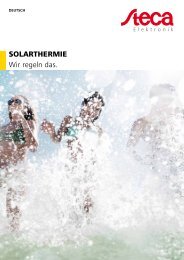Steca Elektronik Catalog PV Off Grid (25|2018)
Create successful ePaper yourself
Turn your PDF publications into a flip-book with our unique Google optimized e-Paper software.
GENERAL RECOMMENDATIONS<br />
selecting the solar controller<br />
SELECTING THE SOLAR CHARGE CONTROLLER<br />
Basic solar charge controllers<br />
The solar charge controller is the central component in a stand-alone system.<br />
It controls the energy flow in the entire system and determines the system<br />
function and service life. This means that a suitable solar charge controller<br />
must be selected carefully.<br />
The solar charge controller only accounts for between 3 % and 5 % of the total<br />
cost of a stand-alone system, and yet it is the most important component.<br />
A high-quality, reliable solar charge controller in a higher price class pays for<br />
itself very quickly, as it increases the battery life and thus leads to a significant<br />
saving in system costs.<br />
48<br />
<strong>Steca</strong> Solsum F<br />
<strong>Steca</strong> Solarix PRS<br />
<strong>Steca</strong> Solsum<br />
<strong>Steca</strong> Solarix MPPT<br />
24<br />
Selecting the topology<br />
<strong>Steca</strong> solar charge controllers are available as professional hybrid-shunt<br />
controllers, serial charge controllers or MPP trackers. A suitable topology<br />
should be selected depending on the requirements of the application.<br />
Switch charge controllers such as shunt and serial charge controllers can<br />
only be used on 12 V systems in connection with 36-cell solar modules. On<br />
24 V or 48 V systems, two 36-cell solar modules (24 V) or two 72-cell solar<br />
modules (48 V) must be wired serially as a string.<br />
Serial charge controllers are well suited to small applications and solar home<br />
systems. Shunt controllers are recommended for larger-scale applications<br />
and hybrid systems, as these have a lower power loss during charging.<br />
Due to their good electromagnetic compatibility, shunt controllers are also<br />
recommended for use in telecommunication applications.<br />
A solar charge controller with MPP tracking must be used when solar<br />
modules which are not comprised of 36 or 72 cells are used. These include<br />
most optimised solar modules for grid-connected systems and all thin-film<br />
modules.<br />
The use of an MPP tracker is also increasingly recommended depending on<br />
the coldness of the average annual temperature and importance of efficient<br />
charging at low battery charges (even when standard 36-cell modules<br />
are used).<br />
User interface<br />
If the solar charge controller is used in an application where persons have<br />
access to the system, it is important that the controller is equipped with a<br />
large LCD screen for displaying the operating statuses using symbols. The<br />
solar charge controller should be equipped with an integrated energy meter<br />
for notifying the user of the system and its operation.<br />
On pure technical systems (such as night-light systems), a solar charge<br />
controller with a simple LED display is sufficient.<br />
Cables and design<br />
In order to ensure a long service life, it is important to use a robust solar<br />
charge controller with short, thick cables for connecting it to the battery.<br />
The device should always be screwed to a non-flammable wall directly above<br />
the battery. It is important that there is enough free space around the solar<br />
charge controller so that it can be cooled sufficiently by the ambient air. The<br />
guidelines in the instruction manuals must be adhered to in all cases.<br />
Additional functions<br />
It makes sense to use solar charge controllers with additional functions in<br />
applications with stand-alone inverters or hybrid systems. The possibility<br />
of connecting to the stand-alone inverters for communication and<br />
synchronisation of the devices is a requirement for effective inverter systems<br />
or hybrid systems. Special energy management functions remain of key<br />
importance on hybrid systems.<br />
12<br />
U Batt<br />
[V]<br />
48<br />
24<br />
12<br />
U Batt<br />
[V]<br />
0 10 20 30<br />
40<br />
Classic solar charge controllers<br />
<strong>Steca</strong> PR <strong>Steca</strong> Solarix <strong>Steca</strong> PR 2020 IP <strong>Steca</strong> Solarix<br />
<strong>Steca</strong> Solarix MPPT 3020<br />
2020-x2<br />
<strong>Steca</strong> Solarix MPPT 5020<br />
10 20 30 40<br />
50<br />
I Modul<br />
[A]<br />
I Modul<br />
[A]<br />
Dimensioning the solar charge controller<br />
The short-circuit current (I sc<br />
) of the solar module is decisive when dimensioning<br />
solar charge controllers (under standard test conditions). <strong>Steca</strong> recommends<br />
always dimensioning the solar charge controller generously. The rated current<br />
on the solar charge controller should be approximately 20 % higher than the<br />
total short-circuit current on all connected solar modules.<br />
Advanced solar charge controllers<br />
<strong>Steca</strong> Tarom<br />
<strong>Steca</strong> Tarom MPPT<br />
<strong>Steca</strong> Power Tarom<br />
48<br />
24<br />
12<br />
U Batt<br />
[V]<br />
0 10 50 100<br />
150<br />
I Modul<br />
[A]<br />
8 9

















